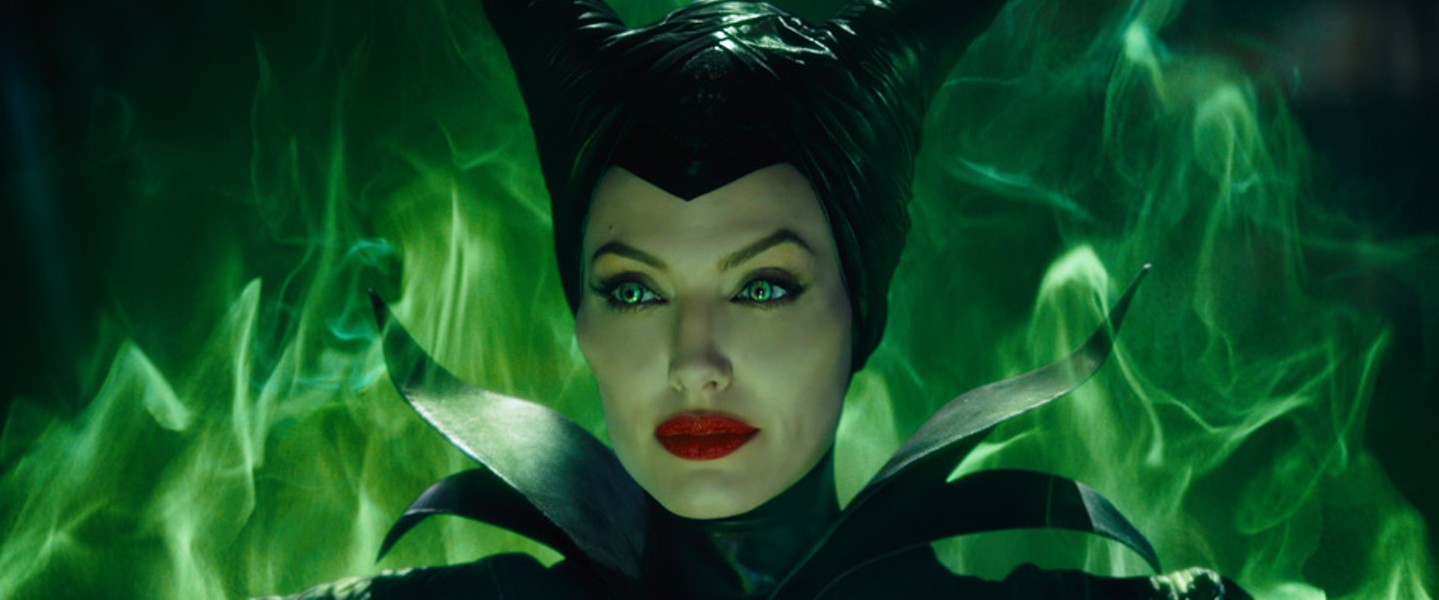When it comes to all-time great movie entrances, you can't do much better than the first appearance of the sorceress Maleficent in Walt Disney's 1959 animated masterpiece, "Sleeping Beauty." With a bolt of lightning, the witch appears, crashing a royal christening to deliver a promise of certain death to an infant, seemingly because the king and queen neglected to send her an invitation to the party. With her flowing black and purple cloak, pale green skin, and that unforgettable horned headdress, there's no mistaking she's the villain of the piece. One of Disney's most iconic characters, Maleficent is a figure of pure malevolence who seems to delight in her own wickedness.
In Disney's "Maleficent," a revisionist fairy tale in the vein of Gregory Maguire's "Wicked," screenwriter Linda Woolverton and director Robert Stromberg recast the character as a wounded woman out for revenge against a patriarchal society that has wronged her. The film is an origin story, though it devotes the majority of its run time to retelling "Sleeping Beauty" from Maleficent's point of view. As the film tells it, Maleficent was once a young, horned and winged orphan living in the peaceful kingdom of the fairies (nevermind that it's awfully cruel for her parents to have named their child "Maleficent," which literally means evil). One day, she meets, befriends, and eventually falls in love with Stefan, a human boy who wanders into the realm from the nearby kingdom of men. He continues to make visits to her as they grow older, but he always leaves to return to the land of men.
The human king has always coveted the fairy realm, and on his deathbed vows that whoever can slay Maleficent (now played as an adult by Angelina Jolie), who acts as its protector, and win the kingdom in the name of men, will be his successor. Stefan (Sharlto Copley, in an oddly stiff performance) sets out to do just that, but finds he can't bring himself to kill Maleficent. Instead, in a disturbing scene, Stefan drugs her, lies with her, and cuts off her wings while she sleeps, leaving Maleficent to wake up the next morning horrified to discover her body has been violated. It's a thinly veiled rape metaphor, which is a rather questionable choice for what's ostensibly a family film, but Stefan's betrayal sets the stage for Maleficent to be reborn as the baby-cursing villain we know and love. But here, Maleficent continues to watch over Aurora (Elle Fanning) as she grows up under the care of the three "good" fairies (hideous, miniaturized, CGI versions of actresses Imelda Staunton, Juno Temple, and Lesley Manville), portrayed here as negligent caretakers who would have allowed the child to die if Maleficent wasn't around to intervene. For years, Maleficent apparently has nothing better to do than skulk around the forest watching Aurora age, allowing the young girl to come to think of her as a fairy godmother.
In theory, it makes sense to give Maleficent a backstory, fleshing out her character to give her motive, but there's a reason the bad guys are always more fascinating characters than the heroes. Turning her into a spurned lover robs her of any mystique she once had, to say nothing of the fact that after "Oz: The Great and Powerful," Disney is apparently operating under the assumption that the only possible explanation for why a powerful woman might turn evil is to get back at a boy. The source of Maleficent's villainy didn't need explanation, and by rewriting her character to strip her of those villainous tendencies feels as though the filmmakers doubted audiences could root for a female antihero. The way she's presented, it's a stretch to even call her an antihero, and by the time she's filmed astride her noble steed, rearing up against a golden sunset as she races to stop her own curse from being carried out, it's pretty clear she's a straight-up hero. Plus, she doesn't even turn into an effin' dragon! Becoming a dragon is Maleficent's coolest power and she doesn't even get to do it -- instead her shape-shifting companion Diaval (Sam Riley) gets that ability.
This is Stromberg's first turn in the director's chair after serving as production designer on films like "Alice In Wonderland" and "Avatar," and as you might expect, he excels at the visuals, but seems lost in most other areas. His lack of directing skill is most egregious during the poorly staged final battle sequence. Thankfully, Angelina Jolie is perfectly cast. She looks fantastic in the part, and she clearly relishes playing devious, but she feels constrained much of the time. She only gets to cut loose during the christening, which is the film's best scene and little surprise, it's the one that's lifted practically verbatim from the animated film. With her sweet nature and infectious smile, I had little trouble buying Fanning as a Disney princess, and her character's relationship with Maleficent functions as a sweet, rather potent metaphor for adoptive motherhood. As Prince Phillip, Brenton Thwaites is given nothing to do whatsoever, though I did appreciate Woolverton's addition of Phillip's reluctance to kiss Aurora without her consent.
Disney's "Maleficent" emerges as a fundamentally misguided interpretation of the title character, one that seems to misunderstand what drew people to her in the first place. As a fan myself, it's hard to imagine another film this summer being as overwhelmingly disappointing a viewing experience.
